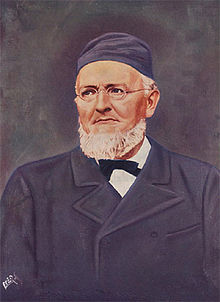Rudolf Winkel
Rudolf Winkel (born September 4, 1827 in Göttingen ; † January 29, 1905 ) was a German mechanic and entrepreneur who excelled in the development and manufacture of microscopes . In 1857 he founded the company “R. Winkel Göttingen ".
Life
Winkel was the son of a teacher. Due to the early death of his father, he was forced to stop attending high school prematurely. In 1841 he began a four-year mechanical engineering apprenticeship at Lipperts Maschinenbau in Hamburg and expanded his manual skills at Eggentorffsche Maschinenfabrik in Hanover.
He then went to Kassel and gained initial knowledge / experience in the construction of precision engineering instruments in the company of FW Breithaupt & Sons. This was followed by several years of wandering, which took him to various workshops in Thuringia, Bohemia and Austria. In 1855 he returned to Göttingen and constructed precision mechanical devices for the University of Göttingen in Moritz Meyerstein's workshop .
In 1857, Rudolf Winkel went into business for himself and rented rooms on Goethe-Allee in Göttingen in order to carry out precision mechanical work for FW Breithaupt & Söhne, Kassel and the Göttingen University. The first apprentice at Winkel became FG Voigt in 1858, who later became the owner of Voigt & Hochgesang.
In the middle of the 1860s, Winkel first dealt with microscopes, as several trichinae epidemics , the research results of Friedrich Albert von Zenker , August Colberg (Hettstedter trichinae epidemic), Robert von Ostertag ("Handbuch der Fleischbeschau" 1892) and Rudolf Virchow on this problem, as well the compulsory trichinae examination of slaughtered meat in the Kingdom of Prussia from 1866 onwards led to increased demand for microscopes. His experience from his apprenticeship was extremely useful because he first had to design all the machines himself. A few years later, Winkel was ready for the market with its first larger microscopes in 1870 . The resulting financial success prompted Winkel to concentrate fully on the manufacture of microscopes.
The mathematics professor Johann Listing , recognized far beyond the borders of Göttingen, was commissioned to compare Winkel's construction with the English microscopes, which were technically superior at the time. The result was extremely positive and this promoted the success of the microscopes from Winkel.
In 1874 the workshop moved to larger rooms at Düsteren Eichenweg 9 at the corner of Baurat-Gerber-Straße in Göttingen. In 1885 the production facility was expanded again. In 1872, 1877 and 1880 the sons Carl Winkel (1857–1908, workshop manager from 1885), Hermann Winkel (1860–1935) and Albert Winkel (1863–1919) joined the father’s workshop as apprentices. In the course of time, you took on tasks as a technical businessman, mechanic and optician. The main work, however, was carried out by the company's founders themselves until old age. In 1890 the company employed 30 people and exported microscopes to England, Austria, Russia and the USA.
After the death of Rudolf Winkel in 1905, his three sons continued the business. In 1907 a new factory building was put into operation in Göttingen's Königsallee. Series production found its way and the production program was significantly expanded. The company presented itself as a specialist in the manufacture of microscopes, which set limits for itself both in production and in sales, and not least through close cooperation with the university. In 1911 the company Carl Zeiss became the main shareholder and the company Winkel was converted into a GmbH.
Individual evidence
- ^ Klaus Henkel: Zeiss, Winkel and Standard. An overview of the microscopes from Carl Zeiss Oberkochen between 1948 and 1990
- ^ Museum of Optical Instruments: Very early microscope by Moritz Meyerstein, Göttingen
- ↑ Voigt & Hochgesang: Large microscope for mineralogical petrographic investigations
- ↑ Very early microscope by R. Winkel Göttingen ... on mikoskop-museum.de, accessed on April 15, 2019
- ^ Pit Schumacher: The Zeiss Punktal Story 1912 - 2012. Bonn 2012
Web links
- Galerie Rudolf Winkel mikoskop-museum.de, archived from the original
- Museum of Optical Instruments: Overview of microscopes at mikoskop-museum.de, accessed on April 15, 2019
- History of ZEISS in Göttingen
- Zeiss, Winkel und Standard An overview of the microscopes from Carl Zeiss Oberkochen between 1948 and 1990 klaus-henkel.de (PDF file; 3.1 MB), archived from the original
- Laboratory microscope Rudolf Winkel
- NN: 100 years of R. Winkel GmbH / Zeiss-Winkel Göttingen. Richard Schorndorfer, Plochingen 1957
| personal data | |
|---|---|
| SURNAME | Winkel, Rudolf |
| BRIEF DESCRIPTION | German mechanic and entrepreneur |
| DATE OF BIRTH | September 4, 1827 |
| PLACE OF BIRTH | Goettingen |
| DATE OF DEATH | January 29, 1905 |
